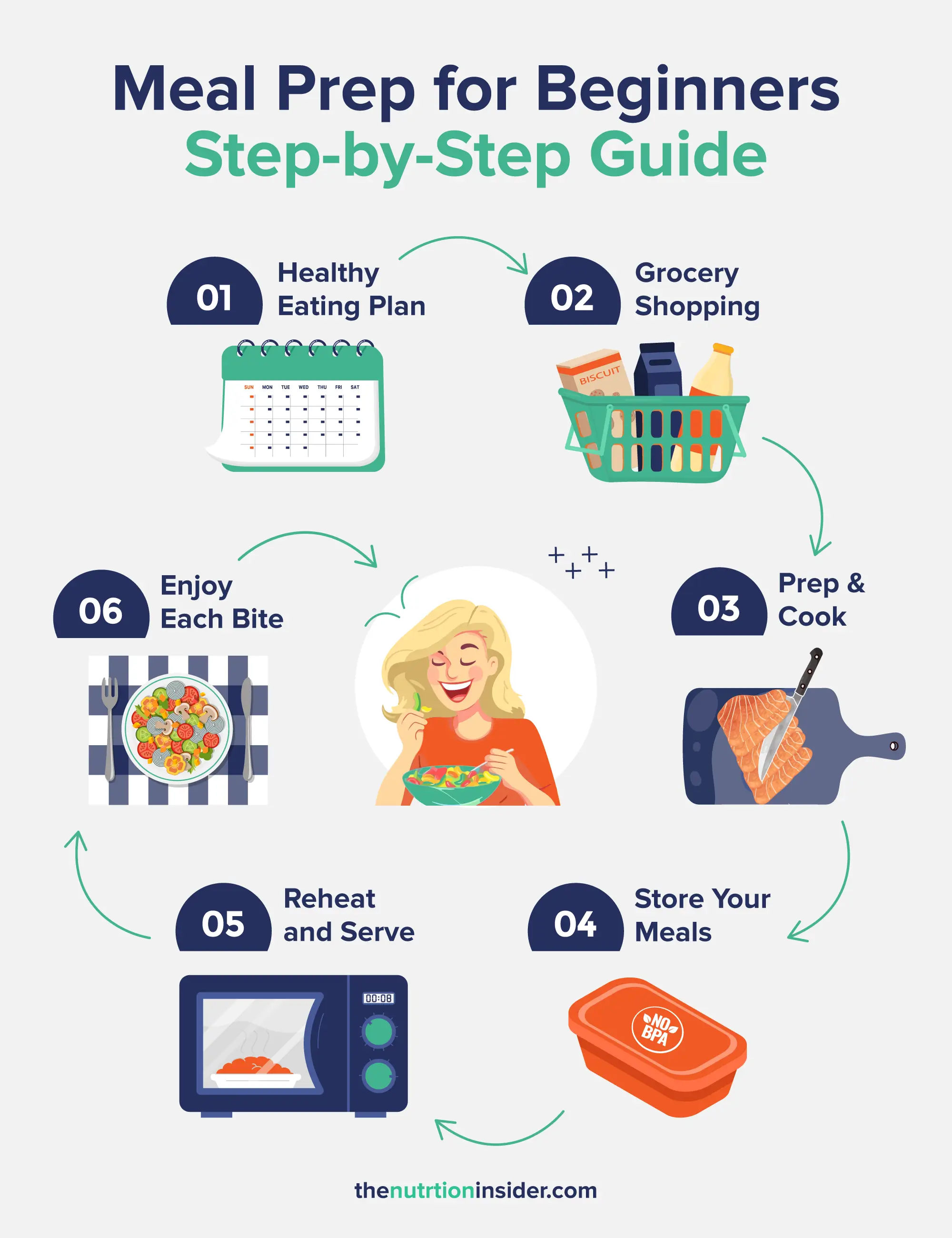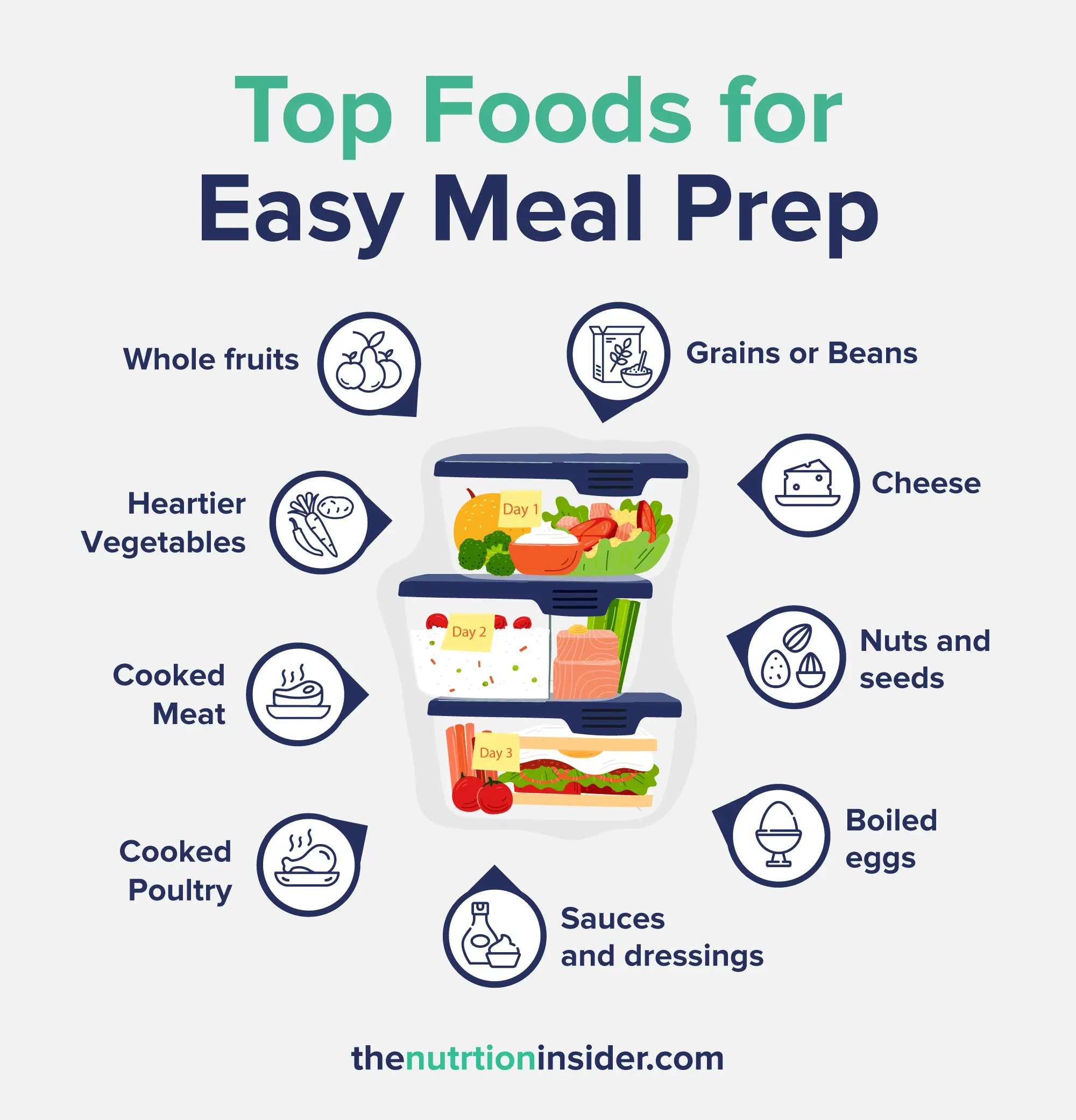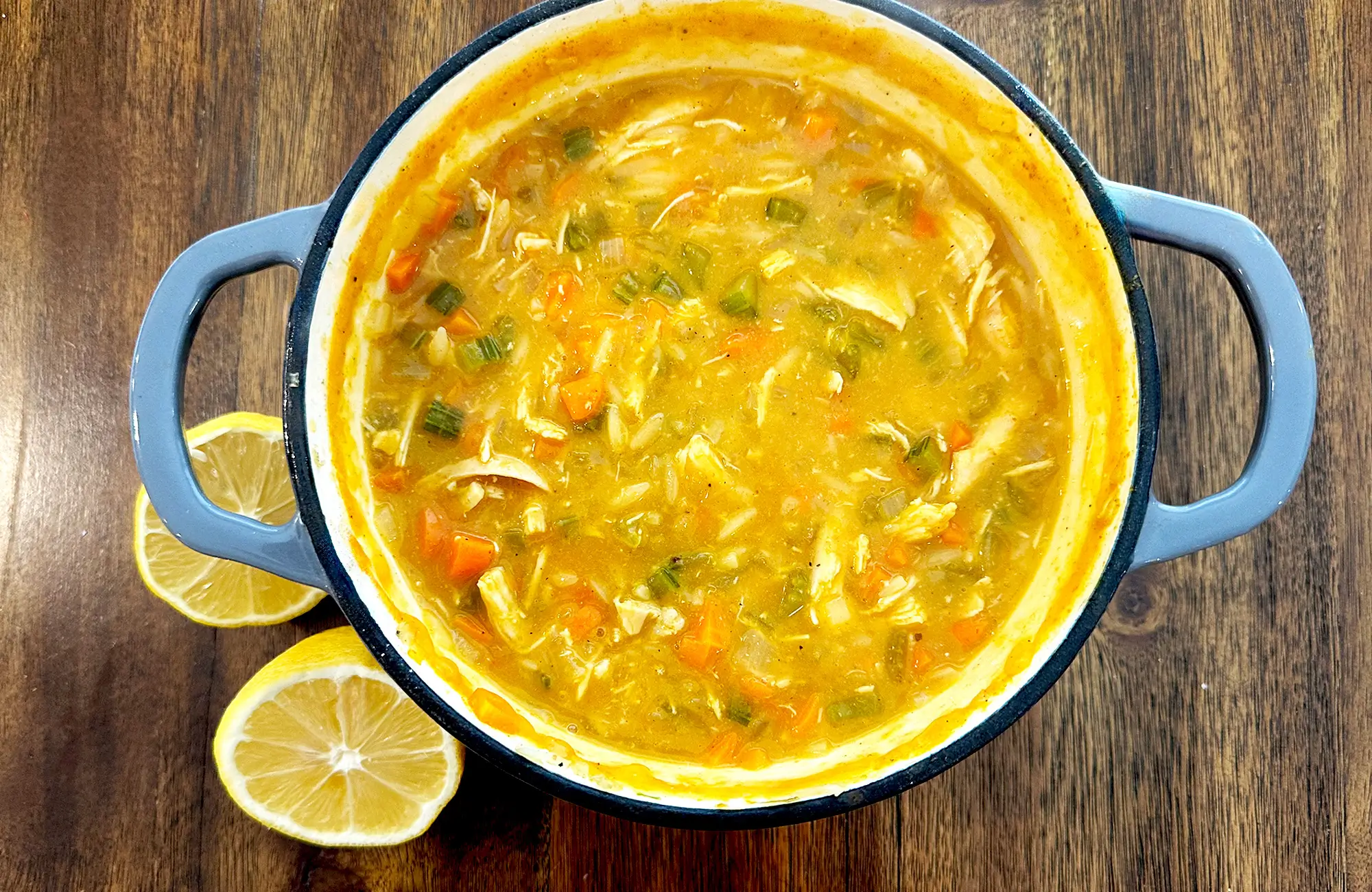This post contains links through which we may earn a small commission should you make a purchase from a brand. This in no way affects our ability to objectively critique the products and brands we review.
How to Start Meal Prepping for Beginners
Evidence Based Research To fulfill our commitment to bringing our audience accurate and insightful content, our expert writers and medical reviewers rely on carefully curated research.
Read Our Editorial Policy
Meal prepping can be a great way to save time, eat healthier, minimize food waste, save money, and meet your health goals.
If you’ve never tried meal prepping before, it can seem like a daunting task. But if you’ve ever taken tonight’s dinner leftovers and packaged them to bring to work for lunch tomorrow, you’ve essentially meal-prepped—we just need to do it on a slightly larger scale.
Not to worry; it’s actually pretty simple. Just follow these five easy steps in this meal-prepping how-to guide, and your fridge will be stocked with delicious meals in no time.
Meals Made for You
Weekly menu, grocery list, macros—one consult unlocks it all.
Meals Made for You
Weekly menu, grocery list, macros—one consult unlocks it all.

How to Start Meal Prepping: Meal Prep Guide for Beginners
Once you get the hang of it, meal prepping is not too challenging—and it can even be fun!

Step 1: At-Home Meal Planning
First, you need to make a solid plan of what you will prepare—no heading to the grocery store without a list!
Your at-home meal planning will need to include:
- Decide how many meals you are going to prep for the week. Are you just making breakfast and lunch, or will dinner and snacks be included? Are you prepping for yourself or also your partner? For a meal prep beginner, starting with just 1-2 days’ worth of one recipe is probably a good place to start.
- Choose your meal prep recipes. Pick recipes you know you enjoy and are easy to prepare. Your first time meal prepping is not the time to whip out that 30-ingredient Bon Appetit recipe you’ve been saving. Healthy meals might include vegetables (or fruit for breakfast), lean protein, healthy fats, and whole grains or beans for fiber. Keep in mind that not all foods work great for meal prepping (like leafy salads).
- Make your grocery list. Write down all the ingredients you’ll need for your chosen recipes. Don’t skip anything and think that you’ll remember it when you’re at the store—you won’t! Make two separate lists if you need to go to a couple of different grocery stores.
What foods work well for meal prepping?
Not all foods are kept well in the fridge or freezer. Some of the best foods that hold up well for meal prep include:
- Heartier vegetables (cooked or raw), such as broccoli, sweet potato, other root vegetables, cauliflower, kale, cabbage, celery, and bell peppers. You can buy frozen vegetables to reduce food waste (in case you don’t use the whole head of broccoli, for example) and make things easier. Leafy greens and lettuces do not work well for meal prep unless you keep all wet ingredients (like dressings or sauces) away from the greens until just before eating. Even then, you wouldn’t want to meal prep a salad more than a day in advance.
- Whole fruit, like apples, oranges, and tangerines, as opposed to fresh berries or cut fruit.
- Cooked grains or beans, including cooked quinoa, pasta, brown rice, and lentils.
- Cooked meat and poultry, such as chicken breasts, ground turkey, ground beef, etc. Picking up a rotisserie chicken can also be a time-saving way to add protein to a meal.
- Hard-boiled eggs
- Cheese, especially hard cheeses.
- Nuts and seeds, including peanut butter and almond butter
- Sauces and dressings, as long as they are kept separate from the other ingredients
You’ll also want to keep crunchy ingredients, like croutons, chips, or crackers, packed separately from other parts of the meal and ideally not in the fridge.

Step 2: Grocery Shopping
Now it’s time to head to the store—you know what to do here! Just ensure you stick to your list to avoid impulse buying, which can increase your overall cost.
When possible, buy in bulk to keep costs down—as long as you have the storage and will be able to eat it in time. Feel free to utilize the freezer section, including frozen vegetables, fruits, precooked grains (like frozen cooked quinoa), and frozen meats or seafood.
Step 3: Prep and Cook Your Ingredients
This will differ depending on which recipes you are planning to prepare, but food prep and cooking steps might include:
- Washing and Chopping Fruits or Vegetables: Clean and cut all the fresh fruit or vegetables you’ll need for the week. Be sure to see what the recipe calls for in preparation (i.e., should you slice or mince that red onion?).
- Cooking Grains or Beans: Preparing larger batches of quinoa, rice, or beans can last 3-4 days in the fridge.
- Cooking Proteins: Ensure you are reaching the recommended internal temperatures for each protein by using a meat thermometer.
- Make Sauces or Dressings: Alternatively, you can use store-bought sauces or dressings to make things easier.
- Use a Slow Cooker: A Crock Pot or slow cooker can be a great way to facilitate easy batch cooking of larger quantities of food. Sometimes, you don’t need to do anything but throw all your ingredients inside, turn it on, and walk away!
As a tip, some people prefer to make an entire recipe when meal prepping, while others prefer to prepare just “ingredients” so they can mix and match when mealtime rolls around. For example, you could cook up several seasoned chicken breasts, ground turkey, a pot of quinoa, pasta, cooked broccoli, roasted sweet potatoes, and a sauce or two. Then, you can decide which components you want to have at each meal rather than having the same thing every day. This may take longer than meal prepping 1-2 full recipes.
Step 5: Store Your Meals
Of course, storing your meals safely is essential to ensure you don’t get sick from foodborne illnesses—and to keep your food fresh longer.
You’ll need plenty of meal prep containers. We recommend glass containers instead of plastic, which are great for reheating and don’t contain potentially harmful chemicals. If you do opt for plastic, ensure it’s BPA-free and labeled as microwave-safe.
Labeling your meal prep containers can also be extremely helpful—especially if you plan to freeze some. Invest in a label marker, or simply rip off a piece of masking tape and write the date you made it on there.
Like all leftovers, meal-prepped food cannot be stored for too long. In the fridge, 4 days is typically the maximum before it goes bad. If you can’t eat it within that time, pop it in the freezer.
Freezing meals reduces food waste if you aren’t able to eat it, but some foods don’t freeze as well as others. High-water raw vegetables, like lettuce, cucumbers, radishes, celery, cabbage, and tomatoes can become mushy when thawed. Cooked pasta, eggs, oil-based sauces, and anything fried or with a breading or crust are also not great for freezer meals.
Step 6: Reheat and Enjoy
You can reheat your meals in the microwave or the oven or stovetop if you’re at home. Ensure your meal prep containers are microwave-safe (or oven-safe) before reheating!
The timing will vary depending on which meal prep recipes you made, but a typical guideline is reheating in the microwave for 60 to 120 seconds. No matter how long you reheat it, it will turn out best if you stop halfway through and mix it up.
Avoid overheating (especially if you have meat or another animal protein in the recipe), as it can quickly dry out. Depending on the meal, sometimes adding a splash of broth or water can help maintain moisture.
If your meal was frozen, ensure adequate time for thawing first, rather than microwaving from frozen.
Tips for Starting With Meal Prepping
- Start Small: If you’re new to meal prepping, start with just a few meals a week to get the hang of it. It can be helpful just to prep one recipe to have for the next few days. For example, instead of preparing multiple meals for breakfast, lunch, and dinner throughout the week, choose to prepare the same meal from one recipe that you’ll eat for the next 2-3 breakfasts (or lunches, etc.).
- Be Flexible: Be willing to adjust your meal plan based on your schedule and food preferences. Don’t force yourself to eat that chicken and rice meal again if you are so over it, and don’t freak out if unexpected dinner plans come up and you have to ditch your meal-prepped meal.
- Keep Things Simple: Choose recipes with minimal ingredients and steps to avoid feeling overwhelmed. Similarly, it’s helpful to plan recipes with similar ingredients. For example, you can bake chicken once and use it in a few different recipes, rather than having recipes using beef, chicken, and pork and needing to cook them all separately.
- Stay Organized: Keep your kitchen and prep area tidy to make the process smoother. Use a French technique called mise en place, which essentially means having everything in its place before cooking. Take out everything that you are going to need (including measuring cups, pots, pans, etc.) for your recipe to make things easier once you start cooking. As a bonus, it also helps you quickly realize if you forgot to get an ingredient before it’s too late.
- Experiment: Try new recipes and ingredients to keep your meals exciting and avoid burnout. Even the most routine-oriented person will still get tired of eating the same things every day!
- Get Inspired: Look through cookbooks, magazines, Pinterest, or other social media to get inspiration for what to make.
- Be Mindful of Storage: If you have a teeny-tiny freezer and your refrigerator is already packed to the brim, know you won’t be able to store much else. Either clear out some room or only meal prep a few days in advance.
Meal Prepping FAQs
Can you lose weight by meal prepping?
Yes, many people meal prep to help them lose weight or achieve another health goal. Of course, if your version of meal prep involves packing up a bag of Cheetos and a frozen burrito, this probably isn’t true. Prepped meals with plenty of vegetables, fruit, protein, and fibrous whole grains or beans can definitely help you on your weight loss journey by making healthy eating easier. One of the main benefits of meal prepping is reducing decision fatigue, which prompts many of us to go for less healthy options when lunchtime rolls around. Instead of feeling famished and heading to the food court for fast food, you know you have a healthy prepped meal ready to eat in a couple minutes or less.
What are the 5 steps to meal prepping?
Meal prepping involves five easy steps: 1.) Meal planning at home to decide what recipes you’re making and what you need to buy. This includes creating a grocery list. 2.) Grocery shopping for your meal prep ingredients. 3.) Prepping and cooking your recipes or ingredients. Batch cooking with a crock pot can be beneficial for saving time. 4.) Store your meals, ideally in glass containers or other microwave-safe storage containers, and label them. For best food safety practices, store it in the fridge for up to 4 days and in the freezer indefinitely. 5.) Reheat your food in a microwave, oven, or stovetop.
What not to do when meal prepping?
A few things not to do when meal prepping include being overly ambitious, like trying to simultaneously make five different gourmet and complex recipes. Keep it simple! This also might mean making different foods without actually cooking recipes, like cooking two different types of lean protein, 2 grains, and two vegetables to mix and match for the next few days. Other things not to do include not labeling your food, making too much food, making recipes you don’t really like, and not storing properly. Lastly, some foods don’t hold up well in storage (like salads and cut fruit).








